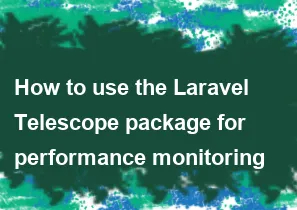How to use the Laravel Telescope package for performance monitoring

Laravel Telescope is an elegant debug assistant for Laravel applications. While it is primarily designed for debugging purposes, it can also be used for performance monitoring to some extent. Telescope provides insights into the requests made to your application, exceptions, log entries, database queries, and more.
Here's a step-by-step guide on how to use Laravel Telescope for performance monitoring:
1. Install Telescope
Make sure you have a Laravel project set up. If not, you can create one using the following command:
bashcomposer create-project --prefer-dist laravel/laravel your-project-name
Navigate to your project directory and install Laravel Telescope using Composer:
bashcomposer require laravel/telescope
Run the Telescope installation command:
bashphp artisan telescope:install
Run the Telescope migrations:
bashphp artisan migrate
2. Configure Telescope
Telescope has a configuration file located at config/telescope.php. You can customize the configuration based on your needs.
3. Start Telescope
To start using Telescope, run the following command:
bashphp artisan telescope
This will make Telescope available at http://your-app-url/telescope. You can access this URL in your web browser.
4. Explore Telescope Features
Telescope provides various features that can be useful for performance monitoring:
Requests: View information about incoming HTTP requests, including request and response details, timing, and more.
Commands: Monitor artisan commands and their execution time.
Jobs: Track information about queued jobs, including their status, execution time, and more.
Exceptions: View information about exceptions thrown in your application.
Logs: Telescope displays your application's log entries in a user-friendly interface.
Database: Track database queries, their execution time, and any potential performance bottlenecks.
5. Analyze Performance Data
Telescope provides an interface where you can analyze the data collected. You can identify slow-performing requests, locate performance bottlenecks, and optimize your application accordingly.
6. Customize Telescope Middleware
If you want to selectively monitor certain routes or actions, you can customize the Telescope middleware. By default, it is applied globally, but you can modify the TelescopeServiceProvider to conditionally enable Telescope based on your requirements.
7. Use Telescope in Production
By default, Telescope is only enabled in the local environment. To use Telescope in production, you can modify the configuration in config/telescope.php to allow it to run in production.
Keep in mind that while Telescope is a powerful tool for debugging and monitoring, it may have a performance impact when used in production. Be cautious and monitor your application's performance when enabling Telescope in production environments.
Always refer to the official Laravel Telescope documentation for the most up-to-date information:
-
Popular Post
- How to optimize for Google's About This Result feature for local businesses
- How to implement multi-language support in an Express.js application
- How to handle and optimize for changes in mobile search behavior
- How to handle CORS in a Node.js application
- How to use Vue.js with a UI framework (e.g., Vuetify, Element UI)
- How to configure Laravel Telescope for monitoring and profiling API requests
- How to create a command-line tool using the Commander.js library in Node.js
- How to implement code splitting in a React.js application
- How to use the AWS SDK for Node.js to interact with various AWS services
- How to use the Node.js Stream API for efficient data processing
- How to implement a cookie parser middleware in Node.js
- How to implement WebSockets for real-time communication in React
-
Latest Post
- How to implement a dynamic form with dynamic field styling based on user input in Next.js
- How to create a custom hook for handling user interactions with the browser's device motion in Next.js
- How to create a custom hook for handling user interactions with the browser's battery status in Next.js
- How to implement a dynamic form with dynamic field visibility based on user input in Next.js
- How to implement a dynamic form with real-time collaboration features in Next.js
- How to create a custom hook for handling user interactions with the browser's media devices in Next.js
- How to use the useSWRInfinite hook for paginating data with a custom loading indicator in Next.js
- How to create a custom hook for handling user interactions with the browser's network status in Next.js
- How to create a custom hook for handling user interactions with the browser's location in Next.js
- How to implement a dynamic form with multi-language support in Next.js
- How to create a custom hook for handling user interactions with the browser's ambient light sensor in Next.js
- How to use the useHover hook for creating interactive image zoom effects in Next.js